The Cooler Master MM731 is a gaming mouse that aims to minimize distractions at hand. It is lightweight and wireless, and there is nothing complicated about its construction or design. It is also priced under $100, which is not an exorbitant price. That said, there are a few shortcomings that prevent us from praising this mouse too enthusiastically to let it compete with the best mice on a crowded market.
The MM731 is essentially a no nonsense gaming mouse, favoring FPS gamers in its simplicity. On the top are the two main switches, the scroll wheel, the RGB backlit Cooler Master logo, and two thumb switches on the left side. On the flip side, there is a Bluetooth/USB/2.4GHz switch, LED status light, pairing buttons, and DPI switch. There is also a small slot to store a USB wireless dongle when not in use.
The main selling point of the MM741 is its wireless connectivity: it can connect directly to devices via 2.4GHz or Bluetooth via the included USB dongle.
Cooler Master's wireless technology works well in both respects: 2.4GHz is provided via a small USB Type-A dongle that instantly connects your PC and mouse when powered on. There was no perceptible delay in this connection, even when the dongle was connected to my PC's cluttered rear I/O.
As for Bluetooth, this is not a connection I would recommend for gaming, as the more widely used Bluetooth connection is not as capable as the dedicated 2.4GHz connection. Polling rates alone are significantly lower with Bluetooth. Nevertheless, the Bluetooth connection is more flexible and useful when playing on devices that lack ports or do not have available ports. For example, I was able to use this mouse on a Dell laptop that only allows USB Type-C connectivity, without having to use one of the precious ports on the USB Type-C to Type-A adapter.
I found myself using this mouse more on the go than my regular Logitech G Pro Wireless Superlight because of this lack of Bluetooth capability. This is a win for Cooler Master.
The mouse can be operated while connected with the included cable. This is a lightweight, flexible USB Type-C to Type-A cable that does not interfere with gaming while the mouse is charging, as the mouse itself comes with a Type-C connector. Cables that pull or redirect the mouse during use are a bit of a pet peeve of mine, so it's nice to see that Cooler Master got it right.
As for weight, the Cooler Master is very lightweight. By my calculations, it weighs 58g without cables or USB dongle. This is about 6g lighter than the Logitech G Pro Wireless, which I use as a benchmark.
However, the Cooler Master feels cheaper for its lighter weight. The overall finish may avoid the real pitfalls of the honeycomb shell, but it still feels rough to the touch. It feels cheaper than other mice I've used in the same price range, and if I'm going to spend this much, I'd like to see a certain level of luxury.
The overall design, however, is designed to fit a gamer's grip, with a gentle slope from the left side of the mouse upward, making it comfortable to hold. Unfortunately, however, the two thumb buttons are not in the position I would prefer. This means that in "Hunt: Showdown," I sometimes have to roll my thumb up to make melee attacks during combat.
However, different grips will have different results here, and some may find this position more preferable than others.
The Pixart sensor tracks my movements well in game and in the test software, but I expect nothing less from the PixArt sensor. The sensor is positioned much further forward on the gaming mouse, but it probably won't make much difference for most people. The MM731 is located well ahead of the Logitech G Pro Superlight.
However, in programming the MM731, we ran into the biggest concern with this mouse: the software.
Cooler Master's Masterplus software let the MM731 down; the MM731's software may be the least sophisticated I have used. It is clunky and the user interface appears half-baked at best. My main complaint is the LED that lights up in a different color on the underside of the mouse when switching DPI, which is not represented at all in the app. This means that I have to set the DPI setting in the app, save it, and then manipulate the mouse to figure out which color represents which DPI setting through trial and error.
The overall functionality of the Masterplus software is mostly there, but it doesn't feel intuitive to use, and these other small details seem to take the shine off this otherwise decent wireless gaming mouse.
There is nothing major wrong with the Cooler Master MM731, but it also struggles to hold anything in particular down. It feels like a $60 mouse at best and still faces stiff competition from Razer. However, the actual price is closer to $90. With the wireless gaming mouse market being so fiercely competitive, the MM731 is not enough to entice me or pull my cash away from the best wireless gaming mice.
.

Comments